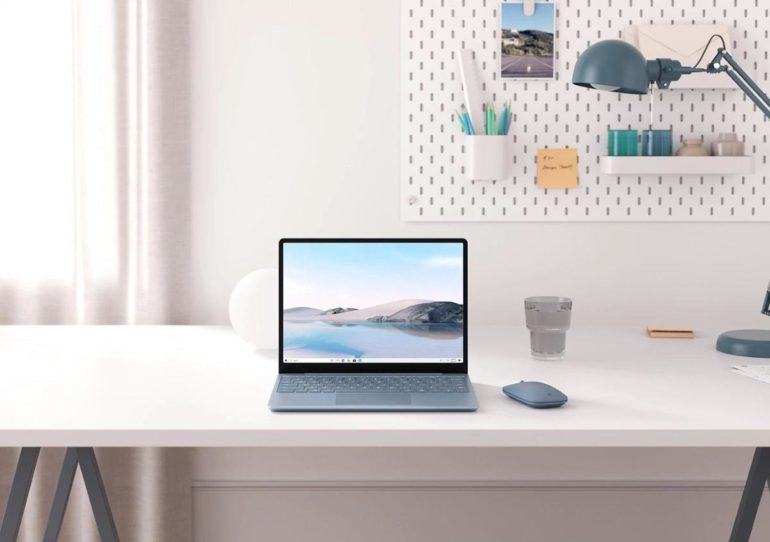Surface Laptop Go
Image: Microsoft
If Microsoft’s new Surface Laptop Go looks familiar, that’s no accident. It’s a smaller, cheaper version of its older cousin, the Surface Laptop, which is now in its third iteration.
This isn’t a laptop for an extreme power user. Instead, it’s aimed at more casual business and personal use cases, where a high-priced enterprise-class machine would be overkill.
The danger of making anything smaller and cheaper is that you run the risk of making it too small and too cheap. After spending a week with the Surface Laptop Go, I can report that it avoids both traps, although I hesitate to recommend the underpowered entry-level configuration.
The consumer version of Surface Laptop Go is available in three configurations.
The entry-level configuration comes with a 10th Generation Intel Core i5 CPU, 4 GB of RAM, and 64 GB of eMMC storage for $550.An upgraded configuration includes the same CPU, with 8 GB of RAM and a 128 GB SSD, for $700.The top configuration also includes 8 GB of RAM with a 256 GB SSD, for $900. I reviewed this configuration.
By contrast, the full-sized 13.5-inch Surface Laptop 3 starts at $979, and the top configuration checks in at a cool $2400.
If you shop at the Microsoft Store for Business or with one of Microsoft’s commercial partners, the entry-level configuration is not available; commercial configurations of Surface Laptop Go include one additional model, with 16 GB of RAM and 256 GB of SSD storage, for $1200.
All configurations are available in Platinum; the two configurations with 8 GB of RAM are also available in Ice Blue and Sandstone.
One week is not enough time to form a fully measured opinion of a new device, so consider this report a first look rather than a formal review.
Honey, I shrunk the laptop
If you’re familiar with the Surface Laptop 3, this device will seem completely familiar, albeit slightly smaller.
The display, for example, is 12.45 inches (measured diagonally), compared to the 13.5 inches of the Surface Laptop 3. The overall package is lighter as well, weighing in at 2.45 lbs (1,110 g) compared to the 2.84 lbs (1,288 g) of the 13.5-inch Surface Laptop.
That ever-so-slightly downsized package means an ever-so-slightly compressed keyboard layout as well. The difference is only about 5/8 of an inch from side to side, and the keys themselves are full size. I had no problem adjusting to the layout and typing at full speed. The Precision Touchpad beneath the keyboard is also full size and works as smoothly as it does on other Surface devices.
As with other members of the Surface family, build quality is impressive. The hinge operates smoothly and stays in position to its maximum extension. Unlike the larger Surface Laptop, this device doesn’t have an all-aluminum case; instead, the top and keyboard cover are aluminum, and the base is made from a “polycarbonate composite resin system with glass fiber and 30% post-consumer recycled content.” There’s a noticeable difference in the appearance of this plastic base, but it feels solid, not cheap or flimsy. It’s also about 1.5 mm thicker than the Surface Laptop 3.
The minimal allotment of ports is identical to the larger Surface Laptop. On the left are a single USB-A port and a single USB-C port, along with a 3.5 mm headphone jack. On the right is a Surface Connect port. The compact 39W charger is capable of Fast Charging the device to 80% in an hour.
Inside, the system includes Wi-Fi 6 (802.11ax) and Bluetooth Wireless 5.0 hardware. The front-facing camera operates at 720p resolution and is accompanied by dual far-field microphones. The combo works great with Skype, Zoom, and other video conferencing software.
Microsoft claims that the Surface Laptop Go will get 13 hours of typical device usage, which is slightly more than the 11.5 hours it claims for the 13.5-inch Surface Laptop 3.
The compromises
Making the Surface Laptop Go smaller and cheaper doesn’t just involve shaving its exterior dimensions. The feature list includes a handful of cost-cutting design compromises as well.
For starters, this model ships with Windows 10 Home in S Mode. If you’re planning to give this PC to a student for remote learning, that might save you some support headaches, but it also increases the risk that they’ll be unable to install a required software package. Fortunately, switching out of S Mode is a simple process. Go to Settings > Update & Security > Activation and use the options under Switch to Windows 10 Home.
If you’re accustomed to the high-resolution display of other Surface devices, you’ll need to scale back your expectations with the Surface Laptop Go. The default resolution is 1536 x 1024, or 148 PPI, compared to the 201 PPI display of the slightly larger Surface Laptop display. My review unit was configured for 100% scaling, which might be appropriate for a teenager’s eyes, but I was far more comfortable after bumping the scaling factor up to 125%.
Although the Surface Laptop Go supports Windows Hello sign-in (with a firmware-based Trusted Platform Module), it doesn’t include the high-end camera required for facial recognition. Instead, the SSD-equipped configurations include a combination fingerprint reader and power button, which conveniently lights up when you need to sign in.
I found the fingerprint reader to be annoyingly inconsistent, even after setting it up multiple times. Most of the sign-in failures seemed to occur when the relative humidity was low, so if you live in a place with normal humidity, this might not be an issue for you.
If you have a Surface Pen, don’t bother trying to use it with the Surface Laptop Go. Although you can pair a pen with the device, the display doesn’t support it.
I was surprised to find that the keyboard isn’t backlit, which makes the experience of using the Surface Laptop Go in a dark (or even dimly lit) environment suboptimal.
The bottom line
Adding the word Go to this laptop’s name invites comparisons with the Surface Go 2, which shrinks the Surface Pro to a freakishly small package with a 10.5-inch screen. Fortunately, there are few other similarities between these two devices other than the Go branding.
The starting price of $550 for the entry-level configuration puts it in the same range as a lot of mass-produced, low-quality devices, and even a few high-end Chromebooks. For business use, I can’t recommend any device that only includes 4 GB of RAM and 64 GB of storage, but it might be acceptable for a student on a tight budget or for use in a shared home environment that doesn’t require more than basic capabilities.
But the lowest-priced SSD-equipped configuration, at a starting price of $700, is easy to recommend, even as a business PC. Historically, Microsoft has used its Surface designs as models for the rest of the PC industry to copy. Looked at through that prism, the Surface Laptop Go is an excellent example of how to build a smaller, cheaper laptop without sacrificing quality.



